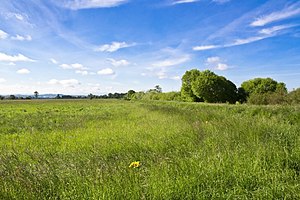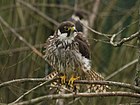Elz lowland between Kenzingen and Rust
|
Bird sanctuary (SPA) "Elzniederung between Kenzingen and Rust"
|
||
| location | Herbolzheim , Kenzingen , Rheinhausen and Riegel am Kaiserstuhl in the district of Emmendingen and Ringsheim and Rust in the district of Ortenau , Baden-Württemberg , Germany | |
| WDPA ID | 555537915 | |
| Natura 2000 ID | DE-7712-402 | |
| Bird sanctuary | 10.85 km² | |
| Geographical location | 48 ° 14 ' N , 7 ° 44' E | |
|
|
||
| Setup date | November 20, 2007 | |
| administration | Regional council Freiburg | |
| particularities | two areas | |
The area Elzniederung between Kenzingen and Rust is one with Regulation of 20 November 2007 of the Regional Council of Freiburg been instructed European bird sanctuary (reserve identifier DE-7712-402) in the Württemberg Baden- districts Emmendingen and Ortenaukreis in Germany .
location
The approximately 1085 hectare (ha) large bird sanctuary "Elzniederung between Kenzingen and Rust" is divided between the communities Herbolzheim , Kenzingen , Riegel am Kaiserstuhl and Rheinhausen in the district of Emmendingen (800 ha) and Ringsheim and Rust in the Ortenau district (285 ha). The two sub-areas are to the west and east of the federal highway 5 , between Rust in the northwest and Kenzingen in the southeast.
description
The protected area "Elzniederung between Kenzingen and Rust" is described as a resting area of national importance and the last large meadow watering area in the southern Upper Rhine plain .
meaning
The bird sanctuary "Elzniederung between Kenzingen and Rust" is one of the most important breeding areas for the curlew and one of the most important breeding areas for gray bunting , lapwing , great gray shrike , quail and white stork in Baden-Württemberg.
Habitat classes
| N09 - dry grassland, steppes | 1 % | |||
| N14 - reclaimed grassland | 55% | |||
| N15 - Other farmland | 38% | |||
| N16 - deciduous forest | 6% | |||
Protection purpose
The area-related conservation objectives are described differently depending on the species :
Breeding birds
Breeding bird species that are listed in Appendix I of the Birds Directive and for which special measures are to be applied across Europe. A total of 39 species fall into this category in Baden-Württemberg and five species in the “Elzniederung between Kenzingen and Rust” protected area .
Hen harrier ( Circus cyaneus )
Preservation of extensively used wet meadows and pastures, of reed areas, of tall herbaceous meadows and fallow land in the grassland areas, preservation of habitats without sources of danger such as non-bird-safe overhead lines and wind turbines, preservation of the food supply, especially with small mammals and small birds living on the ground, as well as maintenance of undisturbed or at least low-disturbance sites during breeding the breeding season from April 1st to August 31st.
Red- backed shrike ( Lanius collurio )
Preservation of extensively managed orchards, grassland and heathland areas, of low and medium hedges from native species, in particular thorn or prickly wooded trees, preservation of litter meadows and open bog edges, preservation of individual trees and bushes in the open landscape, of field lines, grass paths, Ruderal and perennial corridors and fallow land, field and meadow margins, secondary habitats such as abandoned mining sites with the aforementioned habitats and maintenance of the food supply, especially with larger insects.
Red kite ( Milvus milvus )
Preservation of diversely structured cultural landscapes with sparse forests, of field trees, large individual trees and rows of trees in the open landscape, of grassland, of old wood islands and old, large-crowned trees with free approach, preservation of trees with clumps, habitats without sources of danger such as non-bird-safe overhead lines and Wind turbines and the maintenance of undisturbed or at least low-disturbance breeding sites during the breeding season from March 1st to August 31st.
Black kite ( Milvus migrans )
Preservation of diversely structured cultural landscapes, of sparse forests, in particular alluvial forests, of field trees, large individual trees and rows of trees in the open landscape, grassland, islands of old wood and old, large-crowned trees with free approach, especially near the forest edge, preservation of natural flowing and still waters, conservation of trees with clumps, of habitats without sources of danger such as non-bird-safe overhead lines and wind turbines as well as maintenance of undisturbed or at least undisturbed breeding sites during the breeding season from March 1st to August 15th.
White stork ( Ciconia ciconia )
Preservation of extensive, extensively used grassland with wet meadows and cattle pastures, temporally differentiated uses in grassland, of grass, reed and perennial borders, especially in connection with meadow ditches, of high groundwater levels, maintenance of fens, small bodies of water, water ditches and of temporarily flooded depressions , the habitats without sources of danger such as non-bird-safe overhead lines and unsecured chimneys, the nest sites and nesting aids as well as maintaining the food supply, especially with small mammals, amphibians, reptiles, large insects and worms.
Migratory birds
Other migratory bird species not listed in Appendix I that breed in the country and have been selected for the protected areas. A total of 36 species fall into this category in Baden-Württemberg; Eight species have been recorded in the “Elz lowlands between Kenzingen and Rust” protected area.
Tree falcon ( Falco subbuteo )
Preservation of light forests with bordering open landscapes, of old trees and islands of old wood, of overhangs, of field trees or groups of trees in fields or along waterways, of extensively used grassland, of waterways with structurally rich bank areas and silting areas, of nesting opportunities such as crow's nests, of the food supply, in particular with small birds and large insects as well as undisturbed or at least undisturbed breeding sites during the breeding season from April 15 to September 15.
Whinchat ( Saxicola rubetra )
Preservation of largely late-mowed extensively managed grassland complexes, large sedge areas, moors and heaths, fringing strips such as road and field borders as well as edge strips, old grass strips, fallow and wood-free embankments, isolated bushes, tall perennials, piles of stones and others as hunting, sitting and Singwarten suitable structures, secondary habitats such as abandoned mining sites with the aforementioned habitats, the food supply as well as undisturbed or at least undisturbed breeding sites during the breeding season from May 1 to August 31.
Gray bunting ( Emberiza calandra )
Preservation of extensively used grassland areas and richly structured fields, fallow land, strips of field margins as well as grass and shrub fringes, grass and earth paths, field hedges, solitary trees and bushes, preservation of the food supply, in particular with insects as nestling food and wild herb seeds as well as maintenance of disturbance-free or at least low-disturbance breeding sites during the breeding season from April 15th to August 31st of each year.
Curlew ( Numenius arquata )
Preservation of spacious, open and uncut cultivated landscapes without visible barriers, of grassland, in particular of extensively used meadows, of temporally differentiated uses in low-lying meadow complexes, of wet soil conditions with soft, pageable subsoil, of high groundwater levels, preservation of near-natural moors, preservation of the sedges, the Habitats without sources of danger such as overhead lines and wire fences, preservation of the food supply, especially with insects, worms and smaller vertebrates, as well as maintenance of undisturbed or at least undisturbed breeding sites during the breeding season (February 1 to August 31).
Stock dove ( Columba oenas )
Preservation of deciduous and mixed deciduous forests, of old trees and old wood islands, of trees with large caves as well as grassland areas and extensively used fields with fallow land, strips of field margins and weed-rich grass borders.
Lapwing ( Vanellus vanellus )
Preservation of spacious open cultivated landscapes, pastures, poor meadows with patchy vegetation structure, fallow grassland, arable land with late vegetation development and adjacent grassland, flood troughs, occasionally flooded depressions and wet arable areas, preservation of extensively used wet meadow complexes, natural and natural maintenance of river plains undisturbed or at least undisturbed breeding sites during the breeding season from February 1st to August 31st.
Northern gray shrike ( Lanius excubitor )
Preservation of extensive, extensively managed orchards with numerous bushes, of hedge areas with the small structures there such as stone hedges, small fallow land, swampy depressions, individual bushes and trees, unpaved field paths, preservation of grazed juniper heaths with groups of bushes and trees, preservation of lean grassland, of wasteland - and fallow land as well as fringing strips, preservation of the moors with bushes and break forest islands, the springy places and swampy depressions, preservation of uncut landscapes, in particular without paved paths and roads, preservation of the food supply, especially with small mammals and large insects as well as preservation of undisturbed or at least undisturbed breeding sites during the breeding season from February 15th to July 15th.
Quail ( Coturnix coturnix )
Preservation of a richly structured cultural landscape, preservation of widely used arable land, extensively used grassland, in particular of lean grassland with gaps in vegetation structure and a high proportion of herbs, small areas of land with sparse vegetation such as gussets, waterlogged small depressions, sinkholes, swelling patches, small hollows, stone fields , Patches of poor grassland and stone bars, from weed-rich field margins and smaller fallow land, grass, reed and perennial edges as well as maintaining the food supply, especially with various seeds and insects.
Contiguous protected areas
The bird sanctuary "Elzniederung between Kenzingen and Rust" includes the FFH area " Taubergießen, Elz and Ettenbach ", the nature reserves " Johanniterwald " (3.110) and " Elzwiesen " (3.174) and the landscape protection areas "Johanniterwald" (3.16.008) and "Elzwiesen" (3.16.013 and 3.17.020) designated as contiguous protected areas.
See also
Web links
- Ordinance, data evaluation sheet and map in the profile of the SPA area in the LUBW's protected area directory
Individual evidence
- ^ Map of the bird sanctuary “Elzniederung between Kenzingen and Rust” at protectedplanet.net; accessed on February 25, 2019.
- ↑ Profile of the SPA area in the protected area directory of the LUBW , with "Bird Protection Area Ordinance Annex 1"








